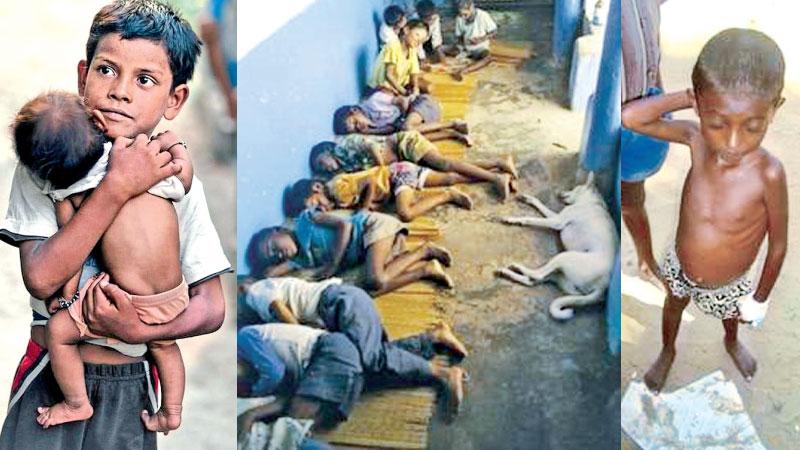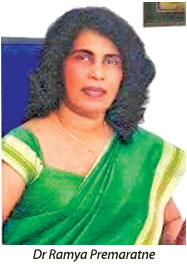
Anaemia among pregnant women is one of the main reasons for the birth of low birth weight babies which leads to stunting and other development problems
While Sri Lanka’s health sector has made significant progress towards achieving the Millennium Development Goals, reducing the number of underweight children under five years as well as child and maternal mortality, combating malaria, polio, leprosy and other infectious diseases to zero levels, certain gaps still need to be filled . This especially, concerns malnutrition, both among women and children, which continues to loom despite on going interventions by the Health Ministry.
While malnutrition is not widespread in all districts, recent surveys have revealed that it is higher than at permissible levels in some districts, especially, where pregnant mothers in low income communities are unable to feed themselves with a proper well balanced meal at least twice a day with a nutritious snack or a cup of fresh milk in between. Many of these mothers have large families to look after and feed, and with their limited resources and single kerosene stoves or open firewood hearths, even boiling a cup of water for tea is sometimes a difficult chore. Added to this, many of them have to battle daily against inclement weather, especially, the bitter cold and rain. Thus, it is not surprising that a recent survey has found that the levels of anaemia and malnutriton are among the highest in Nuwara Eliya and Badulla, the prevalence of low birth weight in the 2012 survey being highest in the Nuwara Eliya district.
The Sunday Observer spoke to Family Physician , Health Ministry, Dr Ramya Premaratne to find out more about the malnutrition status of Sri Lankans and early symptoms to detect it in adults and children . We also asked her what inputs the Health Ministry had made recently to end malnutrition completely.
 Excerpts …
Excerpts …
Q. In spite of the many achievements reported in demographic characteristics, such as, the drastic reduction in fertility rates, maternal and infant mortality levels, and improvement in educational attainments, particularly, of women, malnutrition continues to be a serious health concern . What are the reasons?
A. Malnutrition is a multifaceted problem. It is unevenly distributed and is more prevalent in the rural and estate sectors.
It appears, malnutrition, both chronic and acute develop during the weaning period and rise sharply in the second year of life. Thereafter, the affliction rates show a decline to some degree in the third year, to rise again in the fourth and fifth years when the child attends montessori school. The retardation of growth which commences in the latter half of the first year, points to the grim reality that weaning food given to babies, may not be nutritionally adequate to meet the special dietary needs of the growing child.
Q. So, is intake of weaning food of an infant the main critical factor for malnutrition in children under five years? Are there other contributory factors?
A. Although food intake influences the nutritional status of an individual to a great extent, it is not the only factor responsible for malnutrition, particularly, in the case of children under five years. Living standards, water and sanitation, birth weight, birth interval, parity, sex of child, weaning practices and mother’s education, are a few important contributory factors which have been identified from research studies carried out in the recent past.
However, dietary inadequacy is certainly the basic cause of malnutrition in preschool children, and many of the above identified factors directly or indirectly contribute to the incidence of malnutrition.
Q. Is Anaemia among pregnant women a contributory factor for low birth weight babies?
A. Yes. Anaemia in pregnant women is one of the main reasons for the birth of low birth weight babies.
Q. What about constant bouts of diarrhoea on young children?
A. Diarrhoea is also an illness which has a negative effect on growth and development in early childhood years. Diarrhoeal diseases are still very common among children in Sri Lanka although case fatality rate has dropped greatly in the past two decades.
Q. What are the trends of malnutrition in Sri Lanka?
A. Overall, the situation has improved with long term nutritional deficiencies declining to one third of what it was in the early nineteen eighties. However, wasting or short term nutritional deficiencies have remained at more or less the same level over the years. It appears, malnutrition, both chronic and acute develop during the weaning period and rise sharply in the second year of life. Thereafter, the affliction rates show a decline in the third year, to rise again in the fourth and fifth years when the child attends montessori school.
Q. Any statistics on stunting, wasting and underweight rate in children under 5 years in Sri Lanka?
A. Stunting rate in children under 5 years is 17.3% wasting rate, 14.7 % and underweight is 21.1%.
Q. What are the more prevalence areas of low birth weight, malnutrition, and stunting?
A. The prevalence of low birth weight as shown in the 2012 survey was highest in the Nuwara Eliya district. Other than in the Badulla district, the prevalence of low birth weight among children under five in the Nuwara Eliya, Moneragala and Ratnapura districts was higher than that reported in the 2009 survey.
Although, there was no difference in the prevalence of underweight among children in the four districts, more than one in four was underweight in each district. The prevalence of stunting was highest in the Nuwara Eliya and Badulla districts where more than one in five are stunted; prevalence of stunting was less than 15% in the Moneragala and Ratnapura districts.
Q. What measures has the Health Ministry taken to combat malnutrition?
A. The Ministry has launched a locally designed and acceptable national nutritional project, under which the health sector as well as the non-health sector can make contributions to improve the nutritional status of low income and other communities. These interventions will focus on pregnant mothers and infants.
Q. Good nutrition is considered a key factor in the overall health of our nation? What is ‘good nutrition’?
A. Good nutrition is having the right amount of nutrients in our bodies to give us optimum health during our growing period. Malnutrition leads to sub-optimal growth, poor cognitive development and poor academic performance in children resulting in decreased work capacity and productivity in adult life.
Q. I understand, specific guidelines were developed by the Nutrition Division of the Health Ministry, in consultation with various government ministries, universities, nutrition associations and institutes, consumer and non-governmental organisations, and with the support of the World Health Organisation and UNICEF, towards ending malnutrition. What are they?
A. Yes there is a Food Guide that has been developed especially, for the Lankan population.It is a food pyramid divided into six levels. Rice, breads, other cereals and yams are at the base: vegetables and fruits on the second level; fish, pulses, meat and eggs are on the third level; followed by dairy products, nuts and oils, and fat and sugary products.
Q. What are the constraints, challenges and limitations that face those implementing the project?
A. Lack of a formal mechanism for the continuation of the project. The
internal monitoring system is flawed with no proper system of verifying data. There is no formal monitoring system. Collecting data and recording could not be compiled properly.
There is also no external monitoring, evaluation system and feedback. Motivation of staff including supervisory staff is poor and staff interest will be decreased after a certain period of time. Early coordination of different sectors would be difficult due to administrative and financial regulations but these can be overcome with intervention from higher authorities.
Q. So is there a solution?
A. With regard to implementing nutritional projects, a formal structure needs to be developed for the motivation of staff and sustaining the project. There is also a need for formal monitoring and evaluation.
Q. Does the Health Ministry also supplement the diet of high risk low income groups with locally produced cereals and pulses like Triposha and Samaposha etc? I understand that a nutritious biscuit has just been introduced by the Health Ministry to improve the nutritional level of estate sector children between 2-5 years which is said to be lower than in other parts of the island?
A. Yes. Besides the biscuits which will be given to these children three times a week, Triposha and folic acid is being given to pregnant and lactating mothers free of charge who attend our prenatal and post natal clinics.
Q. In summary, what is your advice to the general public?
A. Regarding nutrition, eat a variety of foods daily, with plenty of vegetables and fruits. Eat cereal-based foods three times a day. I must also remind them that as Lankans we eat too much sugar based foods and salt. Avoid high sugar, high fat, high salt. Also, don’t sit watching T.V. all day. Go outside and exercise daily . Walk, Swim, Run, Skip, and minimise your sedentary activities.
WHO interventions to promote nutrition
The World Health Organisation recently released its REPLACE action package – a step by step guide for the elimination of industrially produced trans-fatty acids from the global food supply. Eliminating transfats is key to protecting health and saving lives. Each year transfats lead to more than 500,000 deaths of people from cardiovascular disease , the report states.
